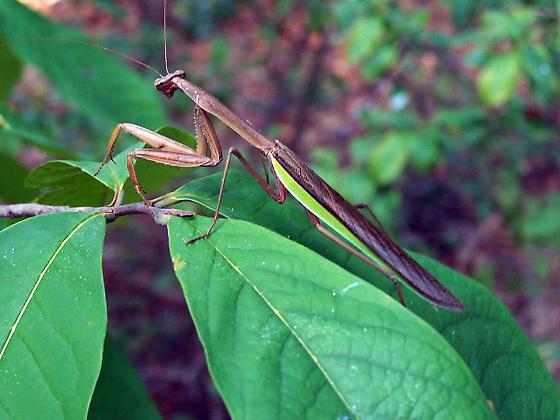As we begin the lengthy process of cutting back our perennials and grasses, I am always on the lookout for some free biological control. Praying mantid egg-casings, known as oothecae, are my primary target. A “hot-spot” for collecting these are in our stand of Mountain Mint (Pycnanthemum muticum), located on our Orchard Trail. Mountain Mint is a great attractor for beneficial insects and the praying mantids seem to favor laying their eggs along the tall, well-hidden stalks. Often it’s not until they are cut and sorted through before going into our compost, that they’re noticed. The casings are well camouflaged. Being light brown in color, they look like a gall that has grown on the stalk. Not only are praying mantid egg-casings interesting to look at, but they are also enjoyable to find and use in your gardens.
These particular oothecae are from the Chinese Mantids (Tenodera aridifolia). Although not native, they are great for controlling more destructive insects such as aphids or mealy bugs. In fact, many garden centers and hardware stores sell their oothecae in the spring just for that purpose. After the casings hatch, there will be over 100 tiny mantids searching for food. They are cannibalistic, so if food is not in abundance, they will feed on their siblings! Chinese Mantids eat anything from aphids to bees to butterflies. Interestingly, they have even been observed ‘gutting’ a Monarch Butterfly to avoid the toxic steroid that the butterfly obtains from consuming the milkweed plant. They can reach 4.5” in full growth and can range from green to gray to light brown in color. In their gray form, they are often seen with a green wing margin. I have noticed large specimens on every trail on site, especially around the Black-eyed Susans on East Terrace.
As you are cleaning outside this year, please take the time to notice any oothecae that might be over-wintering in your garden. If you do find one, keep it outside in the elements and let nature take its course. It will hatch with the warming of spring and will leave you with your own little army of biological control enforcers!
LD: But Cody! If they can eat Monarchs and bees, which are good insects, as well as the bad ones, how do you keep them from running amok in the Crystal Bridges landscape? And aren’t they big enough to eat things like small birds, as well? I think I’ve seen pictures of one of those big mantids catching and eating a hummingbird!
CODY: Keep in mind that not all of the nymphs make it. As soon as they are hatched, they look for food. So, a large percentage of those nymphs are eaten by their brothers or sisters. They are also very susceptible to predators like birds and mice and other insects like the Carolina Mantid (our native mantid).
They CAN eat Monarchs and bees, but they are not high on the list. Mantids are opportunistic, so if they are looking for food and run across a large colony of aphids, they will stay and eat those. I have seen the article with the hummingbird. To me, that’s amazing! I don’t think our population of hummingbirds are in danger due to mantids. The Chinese are the only ones large enough to do that. Our native mantids only get about 2 inches long, so it’s not large enough to eat them. (whew!) -Cody






